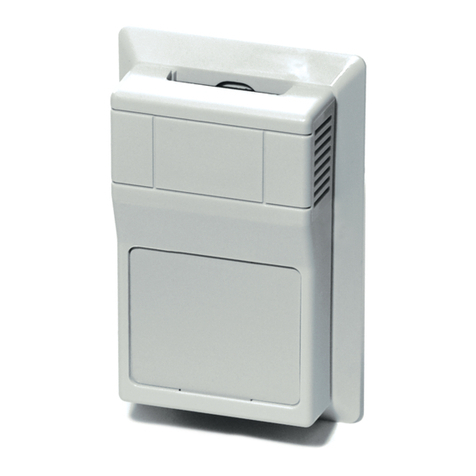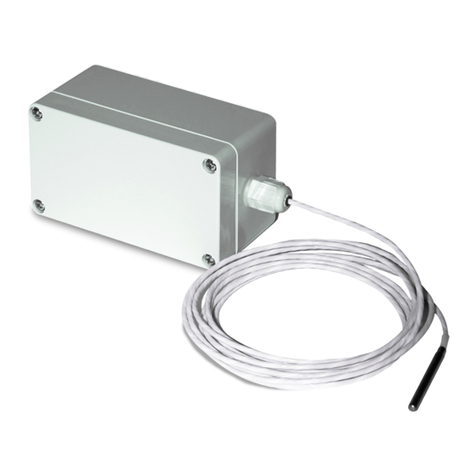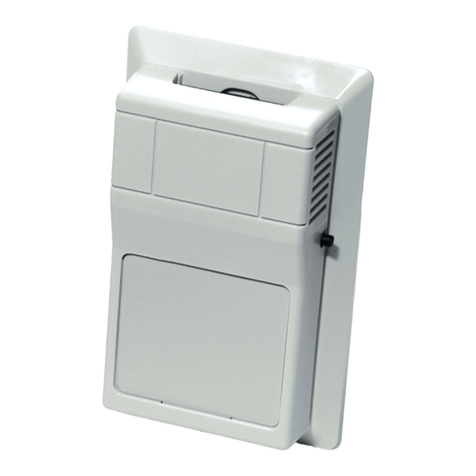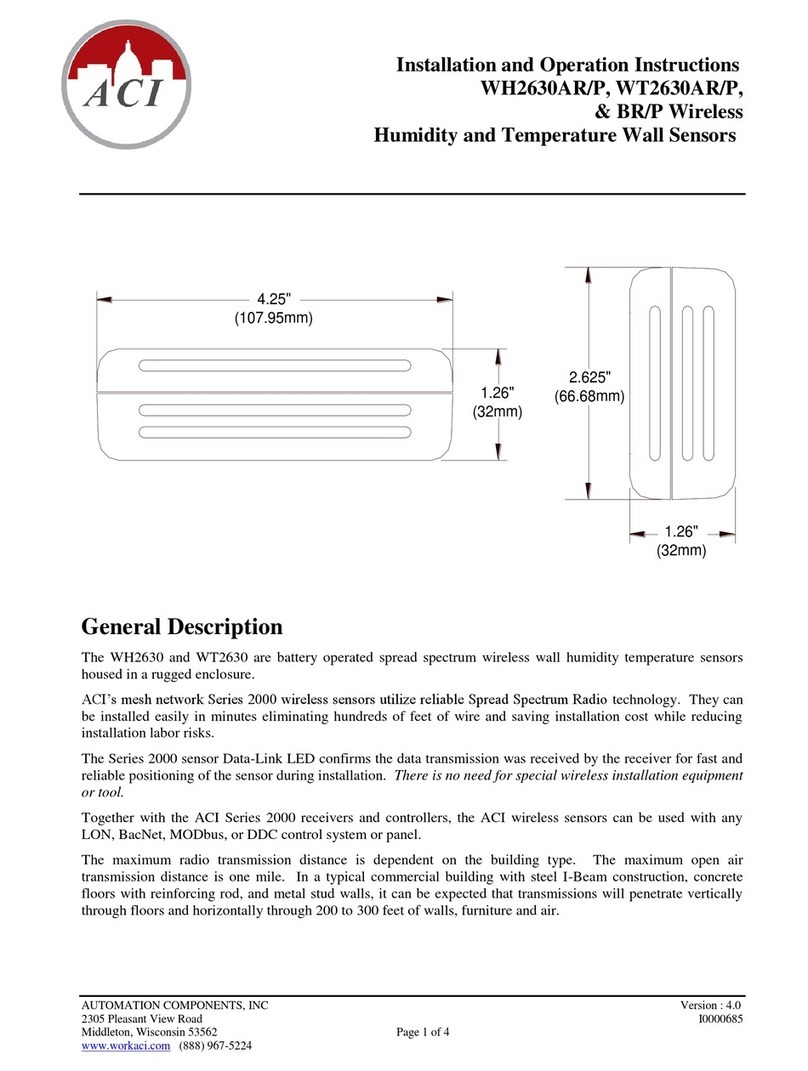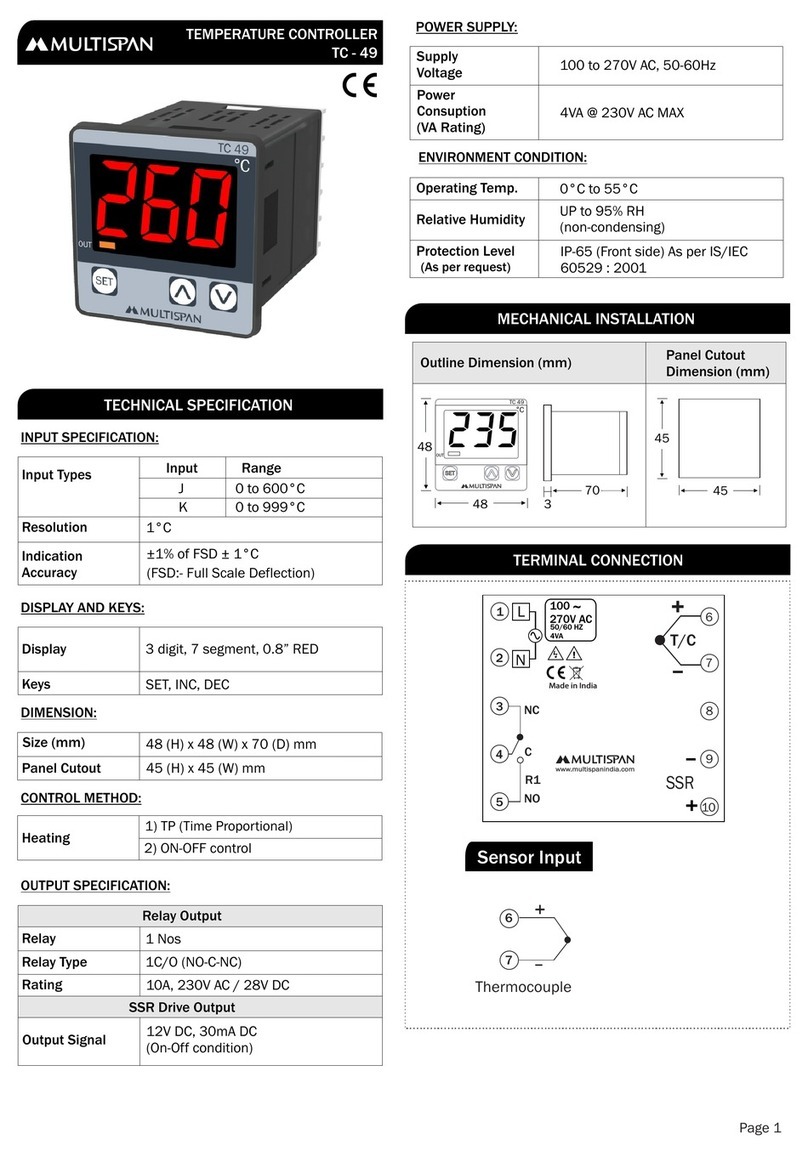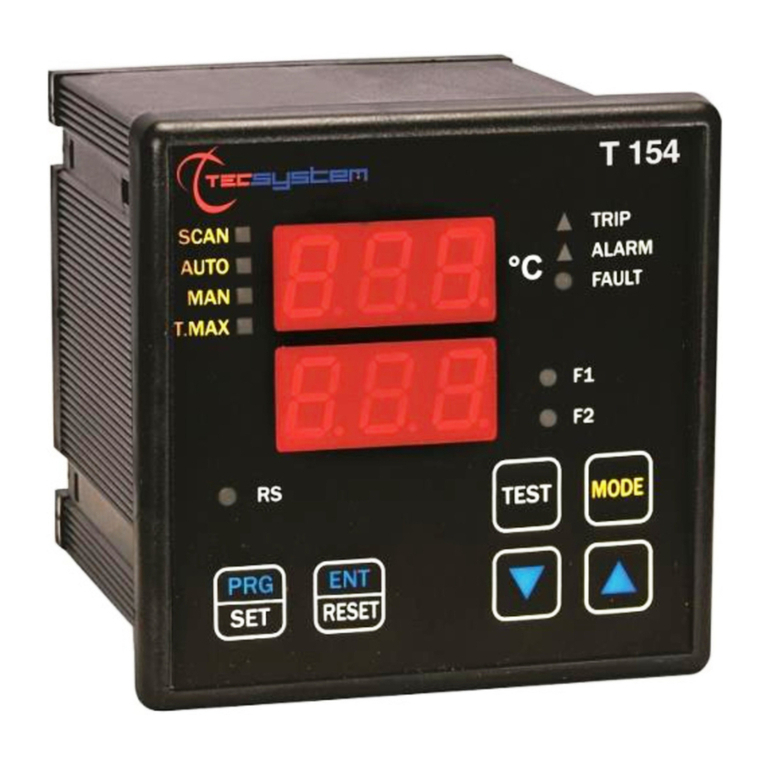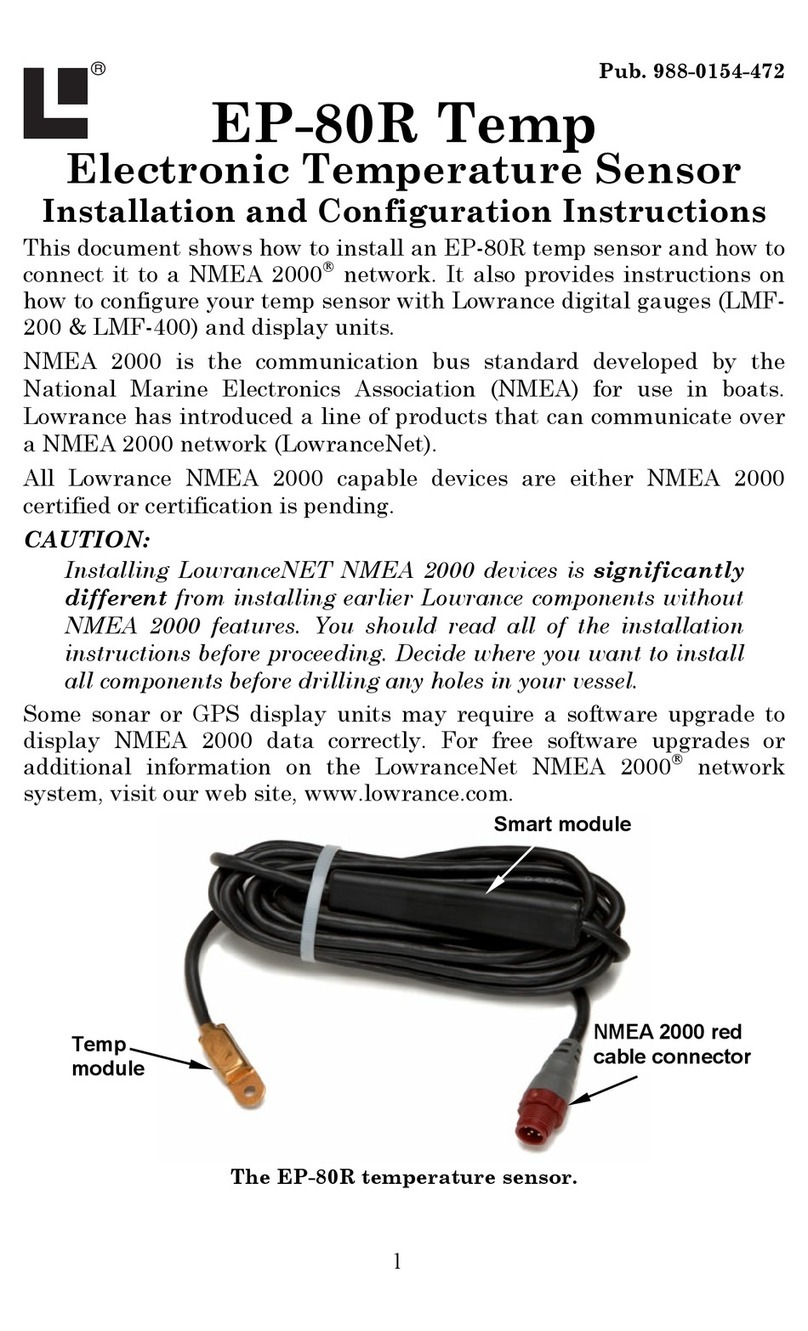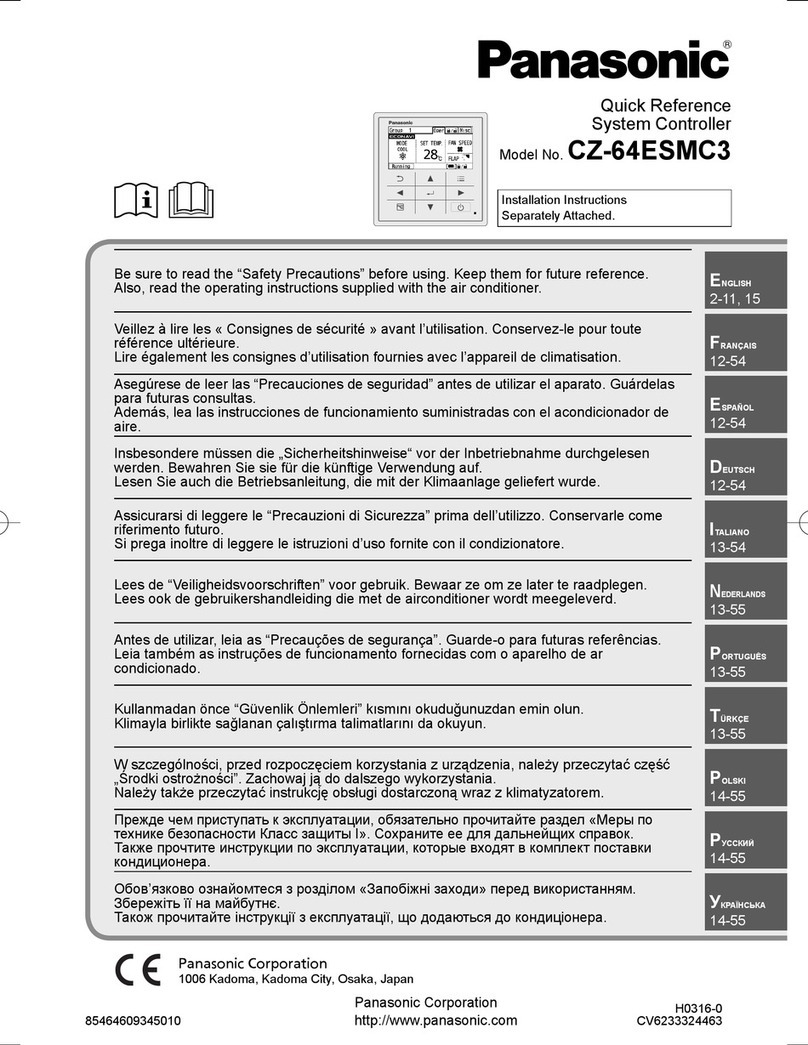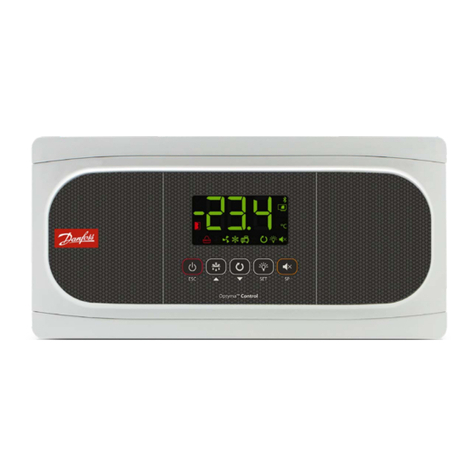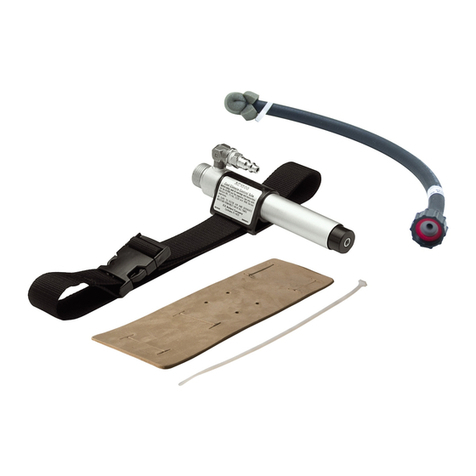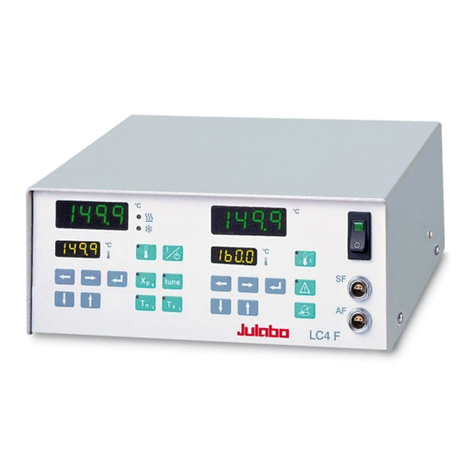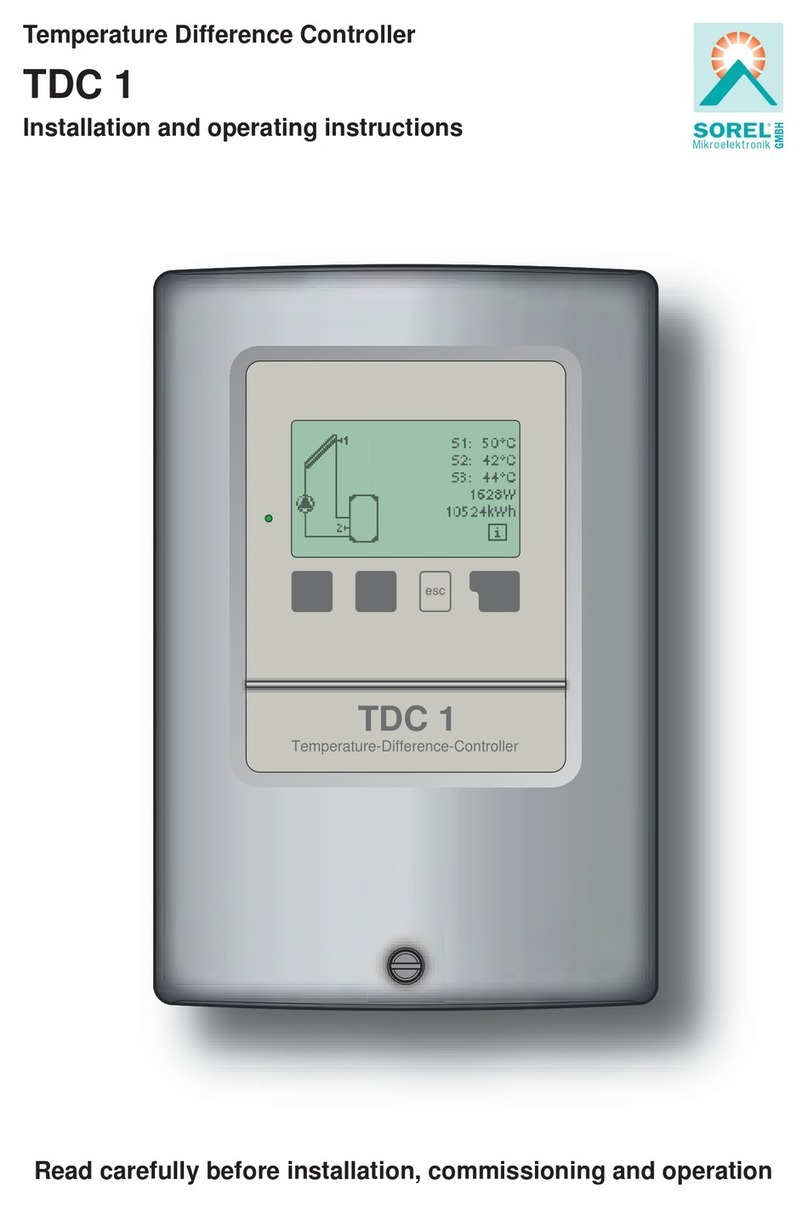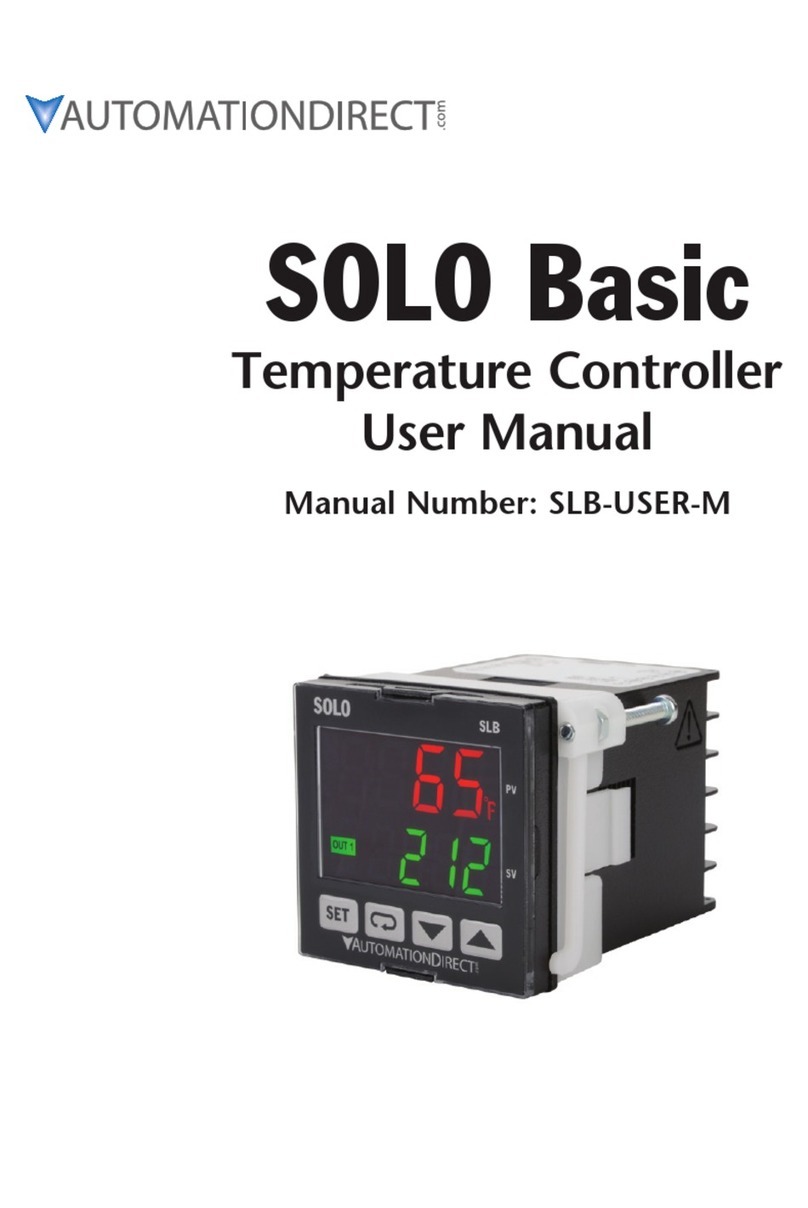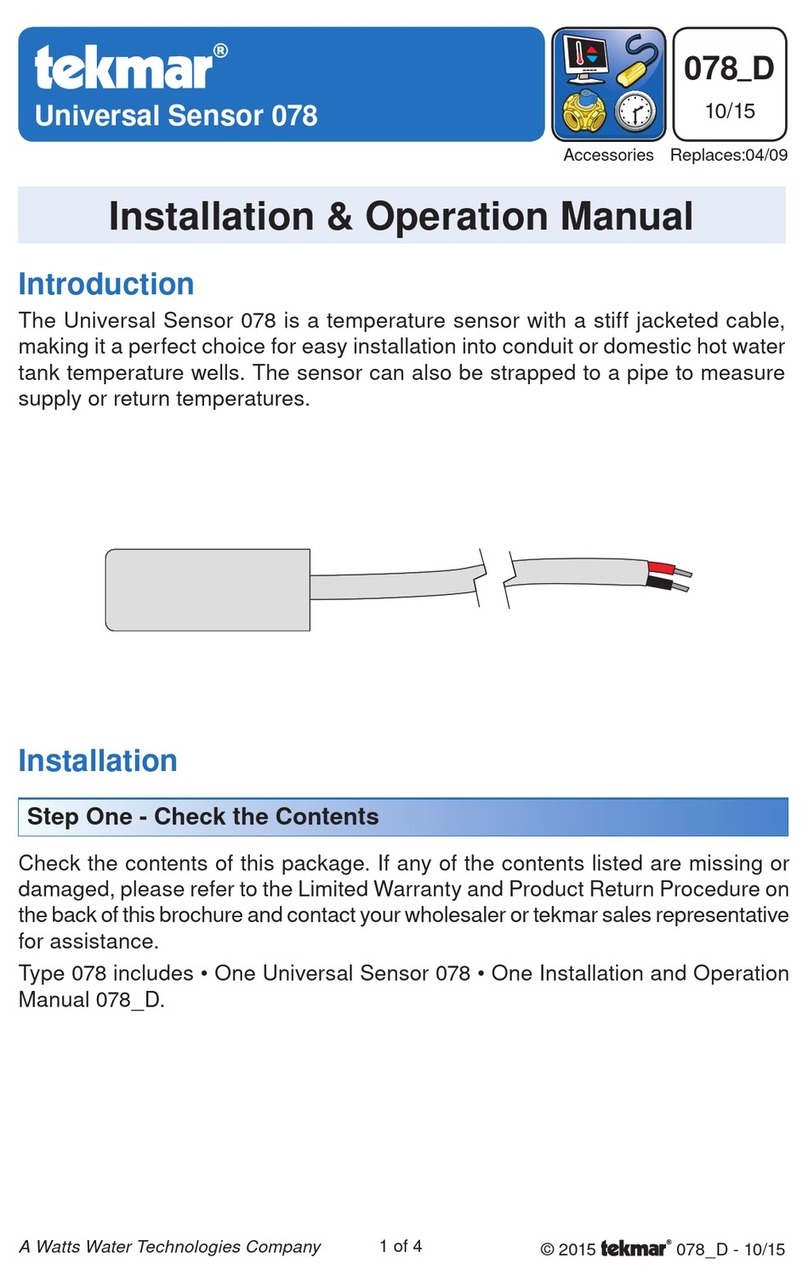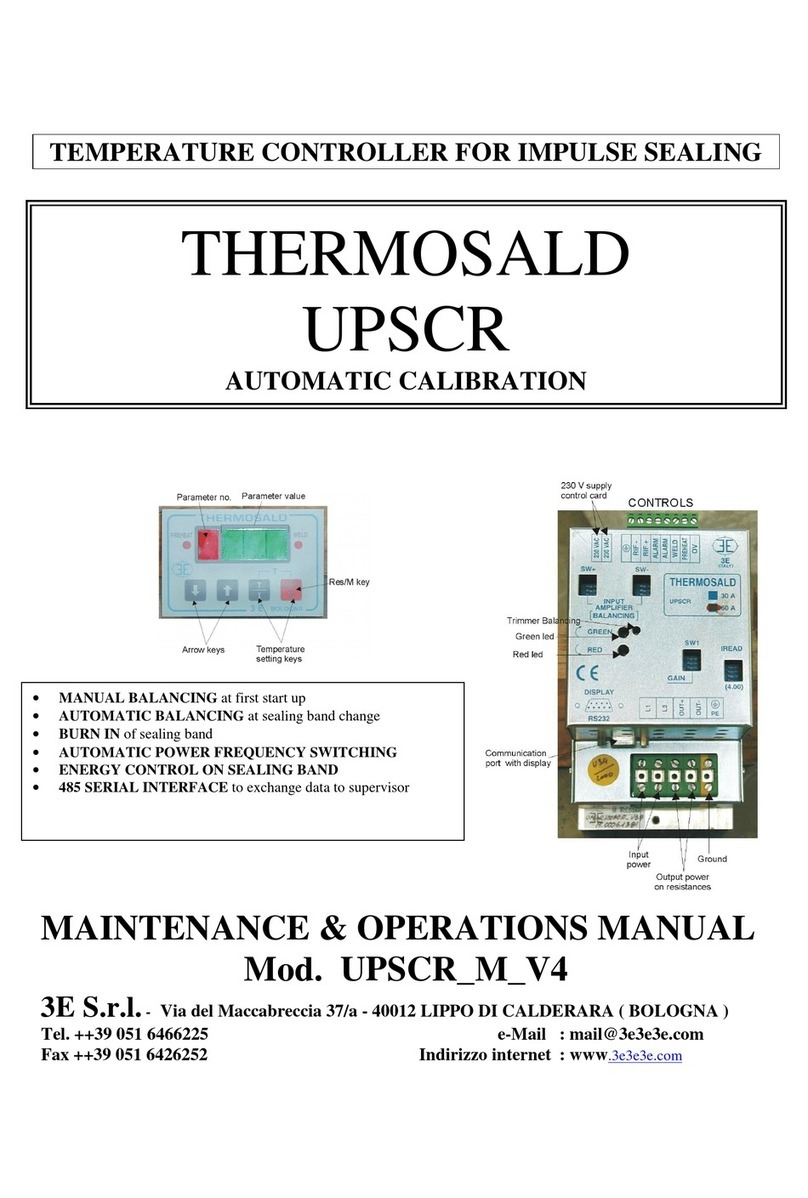aci BACnet Series Installation instructions

Automation Components, Inc.
2305 Pleasant View Road | Middleton, WI 53562
Phone: 1-888-967-5224 | Website: workaci.com
Page 1
Version: 2.0
I0000927
BACnet / Modbus DUCT SERIES
Installation & Operation Instructions Phone: 1-888-967-5224
Website: workaci.com
GENERAL INFORMATION
The BACnet MS/TP / Modbus RTU Duct Series sensor
is designed for use with electronic controllers in
commercial heating and cooling building manage-
ment systems. The ACI BACnet MS/TP /Modbus RTU
Duct Series sensor can be ordered to monitor
temperature, RH, or temp/RH in commercial HVAC
ductwork. It uses BACnet MS/TP or Modbus RTU for
physical connection to a BAS or controller, has dip
switches to set addresses and baud rate, parity and
stop bits (Modbus RTU only) and has on board
end-of-line termination. There is no analog output.
WIRING INSTRUCTIONS
The BACnet/Modbus Duct Series temperature
sensor has a depluggable terminal block located on
the front of the PCB. For ease of wiring, we
recommend removing the block, wiring, and
reattaching before mounting. 16 to 22 AWG two
conductor shielded cable is recommended for
powering the sensors.
ACI recommends using Belden 3105 or compatible
cable for RS-485 communication wiring. This wire has
120 ohm input impendence. The terminal blocks
allow for (1) or (2) wires to be connected in each
position for daisy chaining. Daisy chain the RS-485
wiring and do not use “Star” or “T” wiring. Avoid
running communication wires next to AC line voltage
wires. These can be sources of noise that can aect
signal quality.
PRECAUTIONS
• Remove power before wiring. Never connect
or disconnect wiring with power applied.
• It is recommended you use an isolated
UL-listed class 2 transformer when powering
the unit with 24 VAC. Failure to wire the devices
with the correct polarity when sharing
transformers may result in damage to any
device powered by the shared transformer.
FIGURE 1: ENCLOSURE
DIMENSIONS
EURO (-EH): RH and RH/TEMP.
PLASTIC BOX (-PB): TEMP. ONLY
1.90"
(48.28 mm)
4.30"
(109.22 mm)
3.80"
(96.56 mm)
3.60"
(91.44 mm)
2.25"
(57.15 mm)
1.51"
(38.25 mm)
3.01"
(76.51 mm)
10.05"
(255.32 mm)
2.12"
(53.72 mm)
4.79"
(121.55 mm)
2.35"
(59.80 mm)

Automation Components, Inc.
2305 Pleasant View Road | Middleton, WI 53562
Phone: 1-888-967-5224 | Website: workaci.com
Page 2
TABLE 1: WIRING CONNECTIONS
TERMINAL
BLOCKS
+V
GN
D-
D+
CONNECTIONS
Power Supply Positive 8-34VDC / 10-28VAC
Power Supply Common or Ground
EIA-485 Data Negative
EIA-485 Data Positive
MOUNTING INSTRUCTIONS
(Continued)
Refer to the wiring instructions (p. 2) to make necessary
connections. After wiring, twist the cover until the
enclosure is tightly sealed.
*Reference FIGURE 2
BACnet MS/TP and Modbus RTU
INTERFACE
The BACnet Master-Slave/Token-Passing (MS/TP)
and Modbus Remote Terminal Unit (RTU) data link
protocol uses EIA-485 as a two-wire, daisy chain
network. A branch is a discrete chain of devices
connected to a controller. The max number of
devices per segment is 32, as per the BACnet and
Modbus specications. 4000 ft (1219.2 m) is the
maximum recommended length for a segment,
which includes all devices from the controller to the
last device in the daisy chain.
FIGURE 2: LAYOUT
DIP SWITCH
BAUDADDRESS
OFF
ON
PAR
SW4
BAC
NET
MOD
BUS
RESET
BUTTON
END OF LINE
TERMINATION
LED
EN DIS
D+D-GNV
64
32
16
8
4
2
1
4
2
1
1
ON
1
2
234
TERMINAL
BLOCKS
BAUD RATE SELECTION
By default, BACnet Protocol and Auto-Baud is
factory set. If the sensor is eld adjusted for
Modbus RTU, the baud rate should be selected at
this time to match the Master conguration. If
Modbus RTU protocol is selected it is
recommended the sensor unique address is
selected at this time. Switches 8-10 are used to set
the BACnet and Modbus baud rate. Refer to TABLE
2 for switch settings. Where (0) is OFF and (1) is ON.
If the system’s baud rate is known, it is
recommended to set the specic baud rate to
match the system. If the device is powered when a
change is made, the device must be power cycled
or reset for changes in baud rate to be made.
EOL TERMINATION RESISTANCE
SELECTION
RS-485 requires that the last device in a chain have
a termination resistor. This is controlled using a
jumper in the EN (enabled) position marked on
FIGURE 5. When the jumper is set to EN (enabled), a
120Ω resistance is added in parallel to the data line.
When the jumper is set to DIS (disable), the
resistance is not added. By default, the jumper is
placed in the DIS (disabled) position.
Version: 2.0
I0000927
PRECAUTIONS (Continued)
• DO NOT RUN THE WIRING IN ANY CONDUIT
WITH LINE VOLTAGE (24/120/230 VAC).
• If the 24 VDC or 24VAC power is shared
with devices that have coils such as relays,
solenoids, or other inductors, each coil must
have an MOV, DC/AC Transorb, Transient
Voltage Suppressor (ACI Part: 142583), or
diode placed across the coil or inductor. The
cathode, or banded side of the DC Transorb
or diode, connects to the positive side of the
power supply. Without these snubbers, coils
produce very large voltage spikes when
de-energizing that can cause malfunction or
destruction of electronic circuits.
MOUNTING INSTRUCTIONS
For optimal readings, follow these tips:
• The sensor should be mounted in the middle
of the duct where air circulation is well
mixed (no stratication), and not blocked
by obstructions. Stratication and
obstructions can cause sensing errors. An
example is downstream from a heating or
cooling coil.
• Duct probe should be placed (3) to (4) duct
segments down from any bend or
obstructions and away from 90° bends.
• Mount the sensor on the top or sides of duct work; mounting on the bottom risks damage due to
moisture.
The BACnet/Modbus RTU Duct Temperature-only sensor uses the Plastic Box (-PB) enclosure. Alternatively,
the Euro (-EH) enclosure is used for the Relative Humidity (RH) sensor and RH/Temperature Combo sensor
(see FIGURE 1). Be sure to follow the instructions listed for your enclosure.
PLASTIC BOX (-PB) ENCLOSURE INSTALLATION
Drill a 3/8” hole in the duct and insert the probe through the hole until the foam pad is tight to the duct.
Drill pilot holes for the (2) mounting screws. Use the enclosure ange as a guide, or use the dimensions
listed on page 1 to measure out.
Now fasten and insert (2) screws #8 x ¾”TEK (provided and recommended) through the mounting holes in
the ange and tighten until the unit is held rmly to the duct.
Refer to the wiring instructions (p. 2) to make necessary connections. After wiring, shut the cover of the
enclosure. *Reference FIGURE 2
BACnet or Modbus RTU protocol selection is done
via SW4 switch. Place dipswitch #4 to the OFF
position for BACnet and the ON position for
Modbus. Refer to FIGURE 4.
ACI’s BACnet sensors are master devices. Only
master nodes are allowed to send and receive
tokens on the MSTP network.
ACI’s Modbus RTU sensors are slave devices. Only
one master is connected to the bus and several
slave nodes are connected to the same trunk. The
Master initiates communication. The slave nodes
only respond to a request from the Master. Slave
nodes do not communicate with each other.
Each branch must have all devices connected with
(+) connected to (+) and (-) connected to (-). If a
shielded cable is used, this is not to be connected
to the devices. The shield cable should only be
connected on one end to earth ground, usually at
the controller. The start and end of each branch
should have a termination resistor at the device
level or at the controller.
Each device must be congured for the correct
baud rate and have a unique address in each
branch. The baud rate for the branch is set by the
controller. This product has auto-baud for ease of
network conguration but setting the baud rate
using the DIP switches is recommended. Note:
Auto-baud feature does not function when
Modbus is the selected protocol.
EURO (-EH) ENCLOSURE INSTALLATION
Drill a 7/8” hole in the duct and insert the probe
through the hole until the foam pad is tight to
the duct. Drill pilot holes for the (2) mounting
screws. Use the enclosure flange as a guide, or
use the dimensions listed on page 1 to measure
out.
Now fasten and insert (2) screws #8 x ¾” TEK
(provided and recommended) through the
mounting holes in the flange and tighten until
the unit is held firmly to the duct.
LED INFORMATION
One LED indicates four statuses. Solid green
shows that power is good, but no data is
transmitting. A solid Amber indicates that
auto-baud is set and no data has been received to
set a baud rate. Green/Amber ashing indicates
data is being transmitted or received. Solid Red
LED status indicates an error state, usually loss of
communication on the network. If BACnet is the
selected protocol, and this status remains for 10
times the APDU timeout, the device will
automatically reset. If this state remains longer
than that, reset the device.
ADDRESS SELECTION
Switches 1-7 are used to set the BACnet and
Modbus addressing. Refer to TABLE 3 for switch
settings. Each device in a network branch must
have a unique address. The value of each position
is printed on the board. By default, the address is
(0). Note: (0) cannot be used if Modbus RTU
protocol is selected and will require a unique
address. If the device is powered when a change
is made, the device must be power cycled or reset
for changes in address to be made.
DEVICE CONFIGURATION
THROUGH BACnet
DEVICE INSTANCE
The Device Instance, by default, is 1035000 plus
the Address. For example, an Address of 21 results
in a default address of 1035021. This can be
changed once the device is connected to the
network, but each device instance must be
unique within the network, not just this segment.
RESET
The reset button can be used to reset the device
without disconnecting power. The location of this
button is shown in FIGURE 2 P.2.

Automation Components, Inc.
2305 Pleasant View Road | Middleton, WI 53562
Phone: 1-888-967-5224 | Website: workaci.com
Page 3
MOUNTING INSTRUCTIONS
(Continued)
Refer to the wiring instructions (p. 2) to make necessary
connections. After wiring, twist the cover until the
enclosure is tightly sealed.
*Reference FIGURE 2
BACnet MS/TP and Modbus RTU
INTERFACE
The BACnet Master-Slave/Token-Passing (MS/TP)
and Modbus Remote Terminal Unit (RTU) data link
protocol uses EIA-485 as a two-wire, daisy chain
network. A branch is a discrete chain of devices
connected to a controller. The max number of
devices per segment is 32, as per the BACnet and
Modbus specications. 4000 ft (1219.2 m) is the
maximum recommended length for a segment,
which includes all devices from the controller to the
last device in the daisy chain.
BAUD RATE SELECTION
By default, BACnet Protocol and Auto-Baud is
factory set. If the sensor is eld adjusted for
Modbus RTU, the baud rate should be selected at
this time to match the Master conguration. If
Modbus RTU protocol is selected it is
recommended the sensor unique address is
selected at this time. Switches 8-10 are used to set
the BACnet and Modbus baud rate. Refer to TABLE
2 for switch settings. Where (0) is OFF and (1) is ON.
If the system’s baud rate is known, it is
recommended to set the specic baud rate to
match the system. If the device is powered when a
change is made, the device must be power cycled
or reset for changes in baud rate to be made.
EOL TERMINATION RESISTANCE
SELECTION
RS-485 requires that the last device in a chain have
a termination resistor. This is controlled using a
jumper in the EN (enabled) position marked on
FIGURE 5. When the jumper is set to EN (enabled), a
120Ω resistance is added in parallel to the data line.
When the jumper is set to DIS (disable), the
resistance is not added. By default, the jumper is
placed in the DIS (disabled) position.
FIGURE 4: SW4 DIPSWITCH
SETTINGS
DIP 1 – PAR2 (only applies to Modbus)
DIP 2 – PAR1(only applies to Modbus)
DIP 3 – OPEN (For Future Use)
DIP 4 -- OFF is BACNET, ON is MODBUS
SW4
OFF
ON
1
ON
234
Version: 2.0
I0000927
FIGURE 3: DUCT MOUNTING
PLASTIC BOX
(-PB)
0.875"
(22.23 mm)
0.375"
(9.525 mm)
EURO (-EH)
PRECAUTIONS (Continued)
• DO NOT RUN THE WIRING IN ANY CONDUIT
WITH LINE VOLTAGE (24/120/230 VAC).
• If the 24 VDC or 24VAC power is shared
with devices that have coils such as relays,
solenoids, or other inductors, each coil must
have an MOV, DC/AC Transorb, Transient
Voltage Suppressor (ACI Part: 142583), or
diode placed across the coil or inductor. The
cathode, or banded side of the DC Transorb
or diode, connects to the positive side of the
power supply. Without these snubbers, coils
produce very large voltage spikes when
de-energizing that can cause malfunction or
destruction of electronic circuits.
MOUNTING INSTRUCTIONS
For optimal readings, follow these tips:
• The sensor should be mounted in the middle
of the duct where air circulation is well
mixed (no stratication), and not blocked
by obstructions. Stratication and
obstructions can cause sensing errors. An
example is downstream from a heating or
cooling coil.
• Duct probe should be placed (3) to (4) duct
segments down from any bend or
obstructions and away from 90° bends.
• Mount the sensor on the top or sides of duct work; mounting on the bottom risks damage due to
moisture.
The BACnet/Modbus RTU Duct Temperature-only sensor uses the Plastic Box (-PB) enclosure. Alternatively,
the Euro (-EH) enclosure is used for the Relative Humidity (RH) sensor and RH/Temperature Combo sensor
(see FIGURE 1). Be sure to follow the instructions listed for your enclosure.
PLASTIC BOX (-PB) ENCLOSURE INSTALLATION
Drill a 3/8” hole in the duct and insert the probe through the hole until the foam pad is tight to the duct.
Drill pilot holes for the (2) mounting screws. Use the enclosure ange as a guide, or use the dimensions
listed on page 1 to measure out.
Now fasten and insert (2) screws #8 x ¾”TEK (provided and recommended) through the mounting holes in
the ange and tighten until the unit is held rmly to the duct.
Refer to the wiring instructions (p. 2) to make necessary connections. After wiring, shut the cover of the
enclosure. *Reference FIGURE 2
BACnet or Modbus RTU protocol selection is done
via SW4 switch. Place dipswitch #4 to the OFF
position for BACnet and the ON position for
Modbus. Refer to FIGURE 4.
ACI’s BACnet sensors are master devices. Only
master nodes are allowed to send and receive
tokens on the MSTP network.
ACI’s Modbus RTU sensors are slave devices. Only
one master is connected to the bus and several
slave nodes are connected to the same trunk. The
Master initiates communication. The slave nodes
only respond to a request from the Master. Slave
nodes do not communicate with each other.
Each branch must have all devices connected with
(+) connected to (+) and (-) connected to (-). If a
shielded cable is used, this is not to be connected
to the devices. The shield cable should only be
connected on one end to earth ground, usually at
the controller. The start and end of each branch
should have a termination resistor at the device
level or at the controller.
Each device must be congured for the correct
baud rate and have a unique address in each
branch. The baud rate for the branch is set by the
controller. This product has auto-baud for ease of
network conguration but setting the baud rate
using the DIP switches is recommended. Note:
Auto-baud feature does not function when
Modbus is the selected protocol.
EURO (-EH) ENCLOSURE INSTALLATION
Drill a 7/8” hole in the duct and insert the probe
through the hole until the foam pad is tight to
the duct. Drill pilot holes for the (2) mounting
screws. Use the enclosure flange as a guide, or
use the dimensions listed on page 1 to measure
out.
Now fasten and insert (2) screws #8 x ¾” TEK
(provided and recommended) through the
mounting holes in the flange and tighten until
the unit is held firmly to the duct.
LED INFORMATION
One LED indicates four statuses. Solid green
shows that power is good, but no data is
transmitting. A solid Amber indicates that
auto-baud is set and no data has been received to
set a baud rate. Green/Amber ashing indicates
data is being transmitted or received. Solid Red
LED status indicates an error state, usually loss of
communication on the network. If BACnet is the
selected protocol, and this status remains for 10
times the APDU timeout, the device will
automatically reset. If this state remains longer
than that, reset the device.
ADDRESS SELECTION
Switches 1-7 are used to set the BACnet and
Modbus addressing. Refer to TABLE 3 for switch
settings. Each device in a network branch must
have a unique address. The value of each position
is printed on the board. By default, the address is
(0). Note: (0) cannot be used if Modbus RTU
protocol is selected and will require a unique
address. If the device is powered when a change
is made, the device must be power cycled or reset
for changes in address to be made.
DEVICE CONFIGURATION
THROUGH BACnet
DEVICE INSTANCE
The Device Instance, by default, is 1035000 plus
the Address. For example, an Address of 21 results
in a default address of 1035021. This can be
changed once the device is connected to the
network, but each device instance must be
unique within the network, not just this segment.
RESET
The reset button can be used to reset the device
without disconnecting power. The location of this
button is shown in FIGURE 2 P.2.

Automation Components, Inc.
2305 Pleasant View Road | Middleton, WI 53562
Phone: 1-888-967-5224 | Website: workaci.com
Page 4
MOUNTING INSTRUCTIONS
(Continued)
Refer to the wiring instructions (p. 2) to make necessary
connections. After wiring, twist the cover until the
enclosure is tightly sealed.
*Reference FIGURE 2
BACnet MS/TP and Modbus RTU
INTERFACE
The BACnet Master-Slave/Token-Passing (MS/TP)
and Modbus Remote Terminal Unit (RTU) data link
protocol uses EIA-485 as a two-wire, daisy chain
network. A branch is a discrete chain of devices
connected to a controller. The max number of
devices per segment is 32, as per the BACnet and
Modbus specications. 4000 ft (1219.2 m) is the
maximum recommended length for a segment,
which includes all devices from the controller to the
last device in the daisy chain.
ADDRESS
0
1
12
SW
1
(64)
0
0
0
SW
2
(32)
0
0
0
SW
3
(16)
0
0
0
SW
4
(8)
0
0
1
SW
5
(4)
0
0
1
SW
6
(2)
0
0
0
SW
7
(1)
0
1
0
TABLE 3: ADDRESS SELECTION
FIGURE 5: EOL TERMINATION
JUMPERS
END OF LINE
TERMINATION ENABLED END OF LINE
TERMINATION DISABLED
EN DIS EN DIS
BAUD RATE SELECTION
By default, BACnet Protocol and Auto-Baud is
factory set. If the sensor is eld adjusted for
Modbus RTU, the baud rate should be selected at
this time to match the Master conguration. If
Modbus RTU protocol is selected it is
recommended the sensor unique address is
selected at this time. Switches 8-10 are used to set
the BACnet and Modbus baud rate. Refer to TABLE
2 for switch settings. Where (0) is OFF and (1) is ON.
If the system’s baud rate is known, it is
recommended to set the specic baud rate to
match the system. If the device is powered when a
change is made, the device must be power cycled
or reset for changes in baud rate to be made.
EOL TERMINATION RESISTANCE
SELECTION
RS-485 requires that the last device in a chain have
a termination resistor. This is controlled using a
jumper in the EN (enabled) position marked on
FIGURE 5. When the jumper is set to EN (enabled), a
120Ω resistance is added in parallel to the data line.
When the jumper is set to DIS (disable), the
resistance is not added. By default, the jumper is
placed in the DIS (disabled) position.
Version: 2.0
I0000927
PRECAUTIONS (Continued)
• DO NOT RUN THE WIRING IN ANY CONDUIT
WITH LINE VOLTAGE (24/120/230 VAC).
• If the 24 VDC or 24VAC power is shared
with devices that have coils such as relays,
solenoids, or other inductors, each coil must
have an MOV, DC/AC Transorb, Transient
Voltage Suppressor (ACI Part: 142583), or
diode placed across the coil or inductor. The
cathode, or banded side of the DC Transorb
or diode, connects to the positive side of the
power supply. Without these snubbers, coils
produce very large voltage spikes when
de-energizing that can cause malfunction or
destruction of electronic circuits.
MOUNTING INSTRUCTIONS
For optimal readings, follow these tips:
• The sensor should be mounted in the middle
of the duct where air circulation is well
mixed (no stratication), and not blocked
by obstructions. Stratication and
obstructions can cause sensing errors. An
example is downstream from a heating or
cooling coil.
• Duct probe should be placed (3) to (4) duct
segments down from any bend or
obstructions and away from 90° bends.
• Mount the sensor on the top or sides of duct work; mounting on the bottom risks damage due to
moisture.
The BACnet/Modbus RTU Duct Temperature-only sensor uses the Plastic Box (-PB) enclosure. Alternatively,
the Euro (-EH) enclosure is used for the Relative Humidity (RH) sensor and RH/Temperature Combo sensor
(see FIGURE 1). Be sure to follow the instructions listed for your enclosure.
PLASTIC BOX (-PB) ENCLOSURE INSTALLATION
Drill a 3/8” hole in the duct and insert the probe through the hole until the foam pad is tight to the duct.
Drill pilot holes for the (2) mounting screws. Use the enclosure ange as a guide, or use the dimensions
listed on page 1 to measure out.
Now fasten and insert (2) screws #8 x ¾”TEK (provided and recommended) through the mounting holes in
the ange and tighten until the unit is held rmly to the duct.
Refer to the wiring instructions (p. 2) to make necessary connections. After wiring, shut the cover of the
enclosure. *Reference FIGURE 2
BACnet or Modbus RTU protocol selection is done
via SW4 switch. Place dipswitch #4 to the OFF
position for BACnet and the ON position for
Modbus. Refer to FIGURE 4.
ACI’s BACnet sensors are master devices. Only
master nodes are allowed to send and receive
tokens on the MSTP network.
ACI’s Modbus RTU sensors are slave devices. Only
one master is connected to the bus and several
slave nodes are connected to the same trunk. The
Master initiates communication. The slave nodes
only respond to a request from the Master. Slave
nodes do not communicate with each other.
Each branch must have all devices connected with
(+) connected to (+) and (-) connected to (-). If a
shielded cable is used, this is not to be connected
to the devices. The shield cable should only be
connected on one end to earth ground, usually at
the controller. The start and end of each branch
should have a termination resistor at the device
level or at the controller.
Each device must be congured for the correct
baud rate and have a unique address in each
branch. The baud rate for the branch is set by the
controller. This product has auto-baud for ease of
network conguration but setting the baud rate
using the DIP switches is recommended. Note:
Auto-baud feature does not function when
Modbus is the selected protocol.
EURO (-EH) ENCLOSURE INSTALLATION
Drill a 7/8” hole in the duct and insert the probe
through the hole until the foam pad is tight to
the duct. Drill pilot holes for the (2) mounting
screws. Use the enclosure flange as a guide, or
use the dimensions listed on page 1 to measure
out.
Now fasten and insert (2) screws #8 x ¾” TEK
(provided and recommended) through the
mounting holes in the flange and tighten until
the unit is held firmly to the duct.
LED INFORMATION
One LED indicates four statuses. Solid green
shows that power is good, but no data is
transmitting. A solid Amber indicates that
auto-baud is set and no data has been received to
set a baud rate. Green/Amber ashing indicates
data is being transmitted or received. Solid Red
LED status indicates an error state, usually loss of
communication on the network. If BACnet is the
selected protocol, and this status remains for 10
times the APDU timeout, the device will
automatically reset. If this state remains longer
than that, reset the device.
ADDRESS SELECTION
Switches 1-7 are used to set the BACnet and
Modbus addressing. Refer to TABLE 3 for switch
settings. Each device in a network branch must
have a unique address. The value of each position
is printed on the board. By default, the address is
(0). Note: (0) cannot be used if Modbus RTU
protocol is selected and will require a unique
address. If the device is powered when a change
is made, the device must be power cycled or reset
for changes in address to be made.
BAUD RATE
Auto-Baud
9600
19200
38400
57600
76800
Reserved
SW 8
0
0
0
0
1
1
1
SW 9
0
0
1
1
0
0
1
SW 10
0
1
0
1
0
1
0
TABLE 2: BAUD RATE SELECTION
**Note: Auto-Baud not available for Modbus RTU.
DEVICE CONFIGURATION
THROUGH BACnet
DEVICE INSTANCE
The Device Instance, by default, is 1035000 plus
the Address. For example, an Address of 21 results
in a default address of 1035021. This can be
changed once the device is connected to the
network, but each device instance must be
unique within the network, not just this segment.
RESET
The reset button can be used to reset the device
without disconnecting power. The location of this
button is shown in FIGURE 2 P.2.

Note: The table shows all objects for Temperature and RH. If you have a Temperature only model, the RH objects(AI-1 and
AV-1) will not be present. If you have a RH only model, the Temperature objects (AI-0 and AV-0) will not be present.
TABLE 4: UNIT SETTING
UNITS
°F
K
°C
VALUE
64
63
62
Automation Components, Inc.
2305 Pleasant View Road | Middleton, WI 53562
Phone: 1-888-967-5224 | Website: workaci.com
Page 5
OBJECT TYPE
Device
Analog
Inputs
Analog
Values
BACnet ENGINEERING UNITS
- - - - - - - - - - - - - - - - - - - - - - - - - -
degrees-Fahrenheit (64) - default
percent-relative-humidity (29)
delta-degrees-Fahrenheit (120)
percent-relative-humidity (29)
PIC STATEMENT QR
RANGE
0-4194302
34.7 - 122.0
0.0 - 95.0
-9.0 - 9.0
-10.0 -10.0
OBJECT NAME
BN211x0
Temperature Sensor
RH Sensor
Temperature
Calibration Oset
RH Calibration Oset
OBJECT ID
- - - - - - - - - -
AI-0
AI-1
AV-0
AV-1
TABLE 5: BACnet OBJECT TABLE
DEVICE NAME
By default, the device name is based on the type of device
and the address. The device name can be a character string
up to (32) characters in length. This can be changed once the
device is connected to the network. For example:
Temperature Sensor - 034. The device name must be unique
throughout the entire BACnet network, not just this segment.
TEST MODE BACnet
For the Sensor objects (AI0 and AI1), a test mode can be set by writing the Boolean value true to the
“out-of-service” property. Then the present-value can be set to any valid test value the user requires. This
allows a user to test reactions to specic values returned by this device.
DEVICE LOCATION
The device location is optional but is intended to allow for further denition of the device’s location. The
device location can be a character string up to 64 characters in length.
DEVICE DESCRIPTION
By default, the device description is optional but is intended to allow for further information about the
device or its environment. The device location can be a character string up to 64 characters in length.
TEMPERATURE UNITS CONFIGURATION
For temperature, the units of measure can be congured using BACnet. By writing to the units property of
the temperature sensor (AI0), the reported temperature units can be changed. TABLE 4 shows the values
to write.
TEMPERATURE AND RH OFFSET
This device allows for a temperature oset of +/-5C (9F) and an RH oset of +/-10%. By default, these values
are set to 0, meaning no oset is added.
These are set by writing to the present value of the Temperature Calibration Oset (AV0) or RH Calibration
Oset (AV1). The value written must be within the specied range or an error will be returned. To set back
to factory settings, write any changed values to 0.
Version: 2.0
I0000927

Page 6
PAR 2
0
0
1
1
PAR 1
0
1
0
1
Mode (Databits-Parity-Stop Bits)
8-Even-1
8-Odd-1
8-None-2
8-None-1 (Non-Standard)
TABLE 6: PARITY AND STOP BITS
Automation Components, Inc.
2305 Pleasant View Road | Middleton, WI 53562
Phone: 1-888-967-5224 | Website: workaci.com
1001 0 = Disable Test Mode. IR3 and IR4 will read with current Sensor
Value.
1 = Enable Test Mode. IR3 and IR4 will read with the values stored
in HR1001 and HR1002 .
Test Mode Enable1000
REFERENCE DESCRIPTIONNAMEADDRESS
1
2
3
4
For each bit location:
0 = Sensor not present
1 = Sensor present
Bit 0 - Temperature Sensor
Bit 1 - RH sensor
N/A
For example, a value of 312 would represent 31.2 Degrees of the
units selected in HR1. Signed Integer.
For Example: A value of 429 would represent 42.9% Relative
Humidity.
Sensors Present
Reserved
Temperature Sensor
Value
RH Sensor Value
0
1
2
3
MODBUS RTU MAP
DEVICE CONFIGURATION THROUGH MODBUS RTU
MODBUS RTU DATABITS, PARITY, AND STOP BITS SELECTION
Conrm Modbus Protocol is selected via dipswitch #4 on SW4 - see FIGURE 4. The device that requests
information is called the Modbus Master and the devices giving the information are Modbus Slaves. The
Modbus sensors are slave devices and the number of Data Bits needs to be the same as in the Master
device conguration. ACI’s Modbus RTU sensors utilize 8 data bits during communication exchange.
Parity and stop bit selection is performed via the SW4 switch located on the board. Dipswtiches #1 and #2
are adjusted to select the parity and stop bits - see TABLE 6. Where (0) is OFF and (1) is ON. If BACnet
protocol is selected these dipswitches are irrelevant.
TEST MODE Modbus RTU
There are 5 data values in test mode. Coil 1001,
Holding Registers (HR) 1001 and 1002, and the
Input Registers (IR) 0003 and 0004 for Temp and
RH values. When Coil 1001 is enabled, reading IR
0003 and 0004 will respond with the values in HR
1001 and 1002, other wise they will respond with
the actual sensor values. General process for this
is to write initial test values to HR 1001 and 1002,
Enable Coil 1001 and then read as normal from IR
0003 and 0004. While Coil 1001 is enable, it is
possible to write a change of value to IR 1001 and
1002, which will be reected in the next read from
IR 0003 and 0004. When testing completed,
disable Coil 1001. The status of Coil 1001 and HR
1001 and 1002 are not persistent between
reset/power cycle.
MODBUS RTU MODEL
Modbus data model:
Four (4) primary data tables (addressable registers)
• Discrete Input (read only bit).
• Coil (read / write bit).
• Input register (read only 16 bit word,
interpretation is up to application).
• Holding register (read / write 16 bit word).
INPUT REGISTER IR
Version: 2.0
I0000927
COILS CL

Page 7Page 6
Automation Components, Inc.
2305 Pleasant View Road | Middleton, WI 53562
Phone: 1-888-967-5224 | Website: workaci.com
9003 Thru
9006
9007 Thru
9010
9011 Thru
9016
Always reads a string value of "-123.45" (Null terminated). For
testing proper communication and interpretation of values.
Non-null terminated character string of the Serial Number. For
example, "12345678”
Non-null terminated character string of the Firmware Version. For
example, "02.00.000.90"
Test String Test Value
Serial Number
Firmware Version
9002 Thru
9005
9006 Thru
9009
9010 Thru
9015
INPUT REGISTER IR
2001
2002
2003
2004
9001
9002
Temperature range Minimum value (Tenths). Signed Integer.
Temperature range Maximum value (Tenths). Signed Integer.
Relative Humidity range Minimum value (Tenths)
Relative Humidity range Maximum value (Tenths)
Always reads a value of 54321. For testing proper communication
and interpretation of values.
Always reads a value of -12345. For testing proper communication
and interpretation of values.
Temperature Range
Min
Temperature Range
Max
RH Range Min
RH Range Max
Unsigned Integer
Test Value
Signed Integer Test
2000
2001
2002
2003
9000
9001
HOLDING REGISTER HR
1 Value - Units:
62 - Degrees Celsius
63 - Degrees Kelvin
64 - Degrees Fahrenheit
Temperature Units0
2
3
1001
1002
9001 Thru
9016
9017 Thru
9048
9049 Thru
9080
Temperature Oset Value (Tenths) Signed Integer.
User can set an oset that will be added to Temperature sensor and
reected in IR3. Range of -5.0 to 5.0 degrees Celsius/degrees Kelvin
(-9.0 to 9.0 degrees Fahrenheit).
For example, writing -16 would add an oset of -1.6 degrees.
Relative Humidity Oset (Tenths)
User can set an oset that will be added to RH sensor and reected
in IR4. Range of -10.0 to 10.0 %RH.
For example, writing -16 would add an oset of -1.6 %RH.
User can set what temperature value (Tenths) that would be
returned when reading IR3 and Test Mode is Enabled in CL1001. For
Example -400 would be -40.0.
User can set what RH value (Tenths) that would be returned when
reading IR4 and Test Mode is Enabled in CL1001.
Device Name, Device Location, and Device Description are user
settable character strings (Null terminated) that can be used to allow
for system customization and device identication.
For example:
Device Name (Modbus 9001 thru 9016) could be set to a system ID:
"S2253"
Device Location (Modbus 9017 thru 9048) could be set to:
"Building 5, Floor 2, Duct 3"
Device Description (Modbus 9049 thru 9080) could be set to:
"Cold air return sensor"
Temperature Oset
Value
RH Oset Value
Test Mode
Temperature Value
Test Mode RH Value
Device Name
Device Location
Device Description
1
2
1000
1001
9000 Thru
9015
9016 Thru
9047
9048 Thru
9079
Version: 2.0
I0000927

Page 8
Automation Components, Inc.
2305 Pleasant View Road | Middleton, WI 53562
Phone: 1-888-967-5224 | Website: workaci.com
WARRANTY
The ACI BACnet and Modbus RTU Room Series temperature sensors are covered by ACI’s Five (5) Year
Limited Warranty, which is located in the front of ACI’S SENSORS & TRANSMITTERS CATALOG or can be
found on ACI’s web site: www.workaci.com.
W.E.E.E. DIRECTIVE
At the end of their useful life the packaging and product should be disposed of via a suitable recycling
centre. Do not dispose of with household waste. Do not burn.
BACnet is a registered trademark of ASHRAE. ASHRAE does not endorse, approve or test products for compliance with ASHRAE standards. Compliance of listed products to the requirements of ASHRAE
Standard 135 is the responsibility of BACnet International (BI). BTL is a registered trademark of BACnet International.
Version: 2.0
I0000927
PRODUCT SPECIFICATIONS
12 to 36 VDC / 24 VAC +/- 10%, 50/60 Hz (Reverse Polarity Protected)
25 mA maximum (0.67 VA)
One
-22 to 176°F (-30 to 80°C)
-40 to 302°F (-40 to 150°C)
-40 to 176°F (-40 to 80°C)
@ 77°F (25°C): +/- 1.0°F (+/- 0.5°C)
+/- 9°F (+/- 5°C) (Field Congurable)
One
0 to 100%
@ 77°F (25°C): +/- 2% from 10 to 90% RH
+/- 10% RH (Field Congurable)
4 seconds
BACnet MS/TP or Modbus RTU = Field Selectable; EIA RS-485
0 to 127 (0 (Default - Must be changed if Modbus RTU is selected protocol);
Field Selectable)
Auto Baud (Default, BACnet Only), 9600, 19200, 38400, 57600, 76800, 115200
(Field Selectable)
1035000 + Address (example: Address 127 = 1035127; Field Congurable)
None/Even/Odd = Field Selectable
1 or 2 = Field Selectable
8
Screw Terminal Blocks / 16 AWG (1.31 mm2) to 22 AWG (0.33 mm2)
0.45 lbf-in (0.5 Nm) nominal
-40 to 185°F (-40 to 85°C)
10 to 95% RH, non-condensing
304 Stainless Steel | Diameter: 0.750”(19.05 mm)
“-PB” Enclosure: ABS Plastic, UL94-HB, Plenum Rated
“-EH” Enclosure: ABS Plastic with UV Protectant, UL94-V0
Neoprene/EPDM/SBR Polymer / UL94-HBF; FMVSS-302; MIL-R-6130C
Supply Voltage:
Current Consumption:
Number Temperature Sensing Points:
Operating Temperature Range:
Transmitter:
Sensor (Temp-Only):
Sensor (RH and Temp/RH):
Temperature Measurement Accuracy:
Temperature Calibration Oset:
Number RH Sensing Points:
RH Measurement Range:
RH Measurement Accuracy:
RH Calibration Oset:
Temperature / RH Update Rate:
Communication Protocol:
Sensor Addresses:
Supported Baud Rates:
Device Instance Number:
Parity (Modbus RTU)
Stop Bits (Modbus RTU)
Databits (Modbus RTU)
Connections / Wire Size:
Terminal Block Torque Rating:
Storage Temperature Range:
Operating Humidity Range:
Sensing Probe & Filter Material:
Enclosure Specications:
Foam Pad Material / Flammability:
This manual suits for next models
1
Table of contents
Other aci Temperature Controllers manuals
Popular Temperature Controllers manuals by other brands

Buhler
Buhler TF Series quick guide
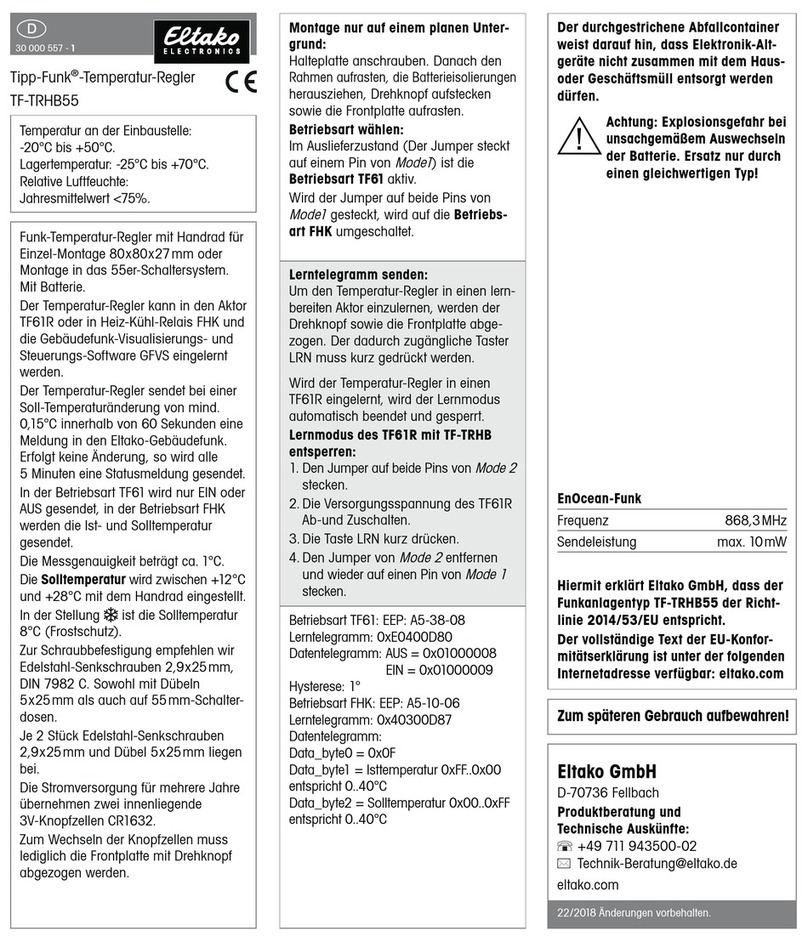
Eltako electronics
Eltako electronics Tap-radio TF-TRHB55 manual

scigiene
scigiene N321R operating manual
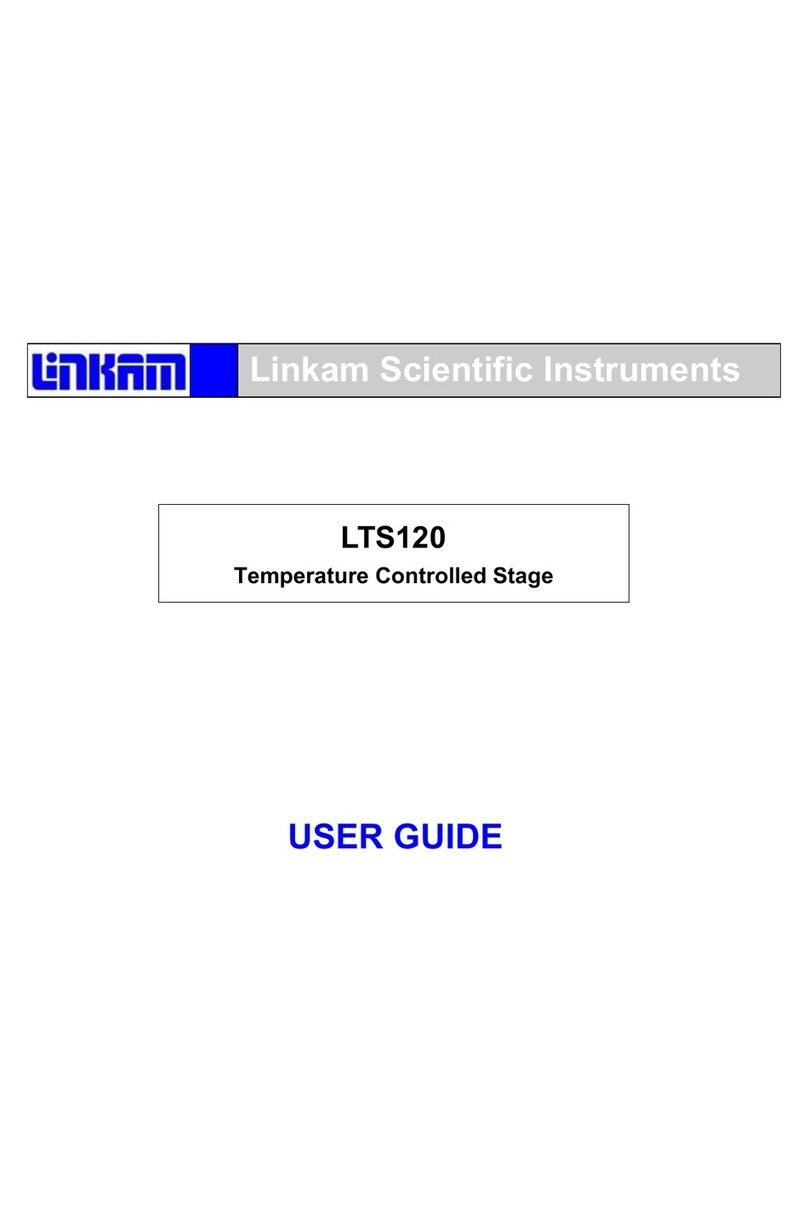
Linkam Scientific Instruments
Linkam Scientific Instruments LTS120 user guide

KELD
KELD KLTX3 Specification and operating instructions
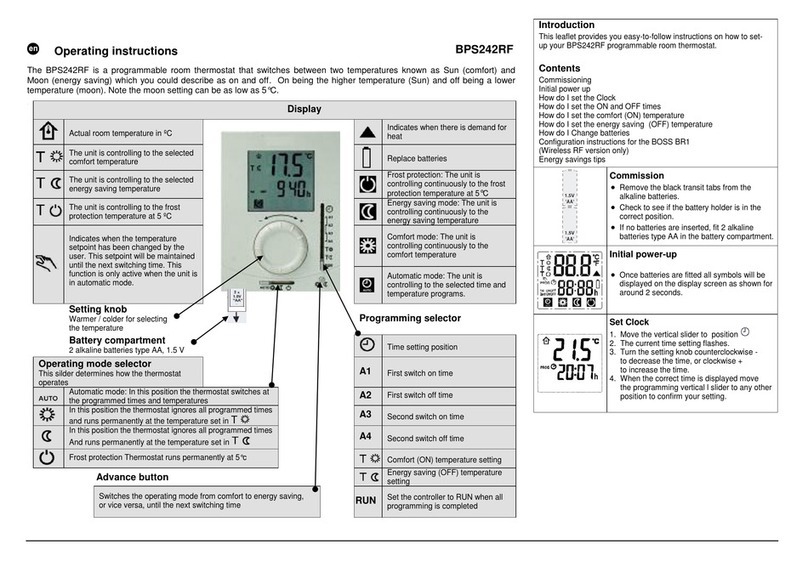
Siemens
Siemens BPS242RF operating instructions
